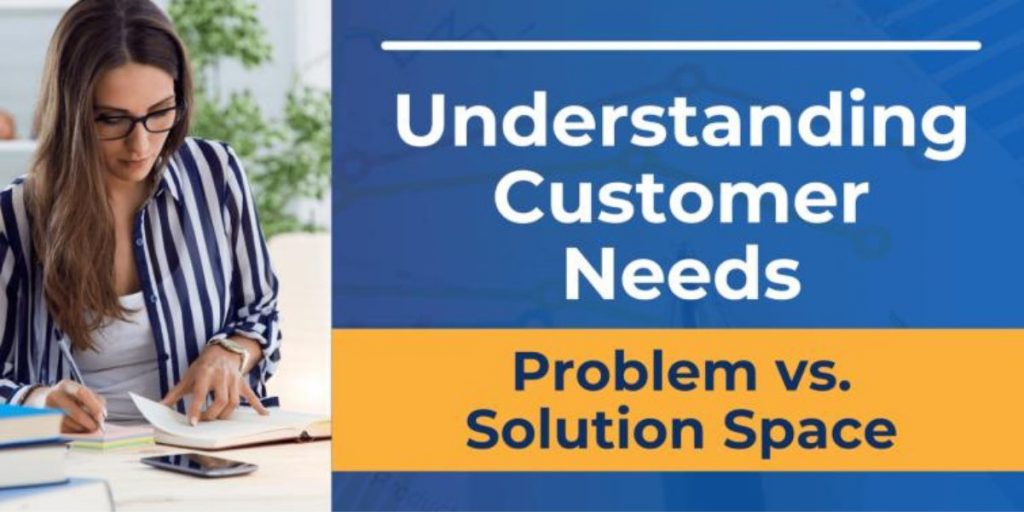
Problem Space:
The Problem Space is where the product team (augmented by cross-functional team members such as CX) spends ample time investigating the customer’s problem, how the problem came to be, why the problem matters, etc. This team invests significant time asking customers everything they can about the problem, seeking a complete understanding. They then validate that understanding with other customers to enrich and confirm they have understood the problem correctly.
This is the first article in a three part series on navigating the Problem vs. Solution Space with a focus on understanding customer needs.
Understanding Customer Needs
“Well, we could…” I stopped myself quickly. I had fallen into the most common of traps. I had stopped paying attention to the customers’ needs and started working on a fix. Product Managers and the teams of developers they work with often tell me that Product Managers have problems writing good requirements. The teams complain that there isn’t enough detail. The Product Managers struggle with how to phrase what they are explaining. And through it all, no one stops to ask a basic question: What problem are we really solving.
I Blame It On The Word Requirement Itself
It has two concepts buried into one word: customer needs and product requirements (sometimes called a solution requirements). Instead of clarifying which one we mean, we start conversations about requirements either in person or with whatever electronic media we choose – and then the confusion starts. The way out of this quagmire is to differentiate between problem space and solution space.
Problem vs. Solution Space
Solution Space:
The Solution Space is where your solution teams (CX, engineering, ops, etc.) investigate possible solutions to the problems uncovered and described in the Problem Space. For many people, it is difficult to stay out of the Solution Space long enough to get a solid understanding of the problem.
Problem Space Conveys What The Customer’s Situation Is
Diving deep into what the customer’s problem is takes time and isn’t always comfortable unless you explain what you are trying to do. Sometimes customers listening to me ask questions and look uncomfortable since I keep asking for more and more detail. It’s as though I’m taking too long. I can almost hear them thinking: “Maybe she doesn’t have the skills to know how to fix it. Maybe she’s stalling until she comes up with a good answer.” I have to stop and explain the process and then the customer regains confidence. Over time, I’ve come to see this time of confusion as an opportunity to slow down the process of making a move towards a solution until all the pieces of the problem have been exposed, turned over and examined. Impatience in others is a signal that I’m on the right path.
Solution Space Is The Part We Are All Drawn To
It’s when we get to pull a rabbit out of a hat with an answer. Most of our schooling relies on our ability to solve a problem and give the correct answer. Our development teams feel most comfortable working in this area as well. If, when you define the problem space more accurately, you are writing good requirements, your engineering team will then be able to define the answer to the customer needs and problem you are presenting.
The following quote has been incorrectly attributed to Albert Einstein. It neatly sums up how we should approach any issue we are trying to resolve:
If I had only one hour to solve a problem, I would spend up to two-thirds of that hour in attempting to define what the problem is.
If we constantly slide between problem and solutions spaces, focusing your team on clear boundaries between these spaces will go a long way to making sure that when you finally have a customer requirement that it’s the right one. One that you’ll have evidence to support and that your team understands fully.
4 Ways To Keep Your Team On Track
1. Ban The Word “Requirement” On Its Own
Instead of requirement, ask people to use the words ‘customer need’ for a problem and ‘product feature’ for a solution. Talk in terms of customer problems/pain points/needs and then corresponding feature descriptions to meet that need. This linguistic hygiene avoids team members slipping from a discussion about problems into a discussion about solutions without anyone realizing that the discussion has switched.
2. Make A Sign
Tape two sheets of different colored paper together and write a large P on one side and a large S on the other. Put it in the middle of the table. When the conversation switches to discussing a solution instead of the problem, flip the paper over. If the switch is premature, get your team working to turn the discussion towards the problem space. Once it is, turn the paper back to the side marked P.
3. Hide Solutions While Working On Problems
It can be difficult to stay focused on the problem if you have a brilliant solution. Give team members large sticky notes. If they discover a solution, they can write it down and turn the paper over. The discussion should remain focused on the problem space. If you take a break, the sticky notes can be posted on the back side of flip chart paper – out of sight. When it’s time to discuss possible solutions, review the ideas that came up. Chances are a lot of them no longer apply, but the process can make solutions-oriented folks more able to feel like their ideas are written down and they can then focus on the problem again.
4. Brainstorm Problems With As Much Enthusiasm As You Brainstorm Solutions
Hold a customer problem brainstorming session with many different departments and functions in attendance. Give prizes for the most ideas, strangest customer problem discovered, group prizes for those who come up with the same customer problems. This is great activity early on in the process when your team isn’t sure what they have to do next or teams who want to expand the breadth of problems that they should be addressing. Have fun giving out the prizes!
What’s Next
Once your problem space is clear, move onto the next steps:
Validate, Prioritize And Then Solve The Problem
Have a culture of validating the problems with as much energy as you put into identifying potential solutions. Create a system for validating each problem and then set aside time to prioritize which ones are most important. And finally, develop solutions to each problem your team has decided to solve. Words are imperfect communicators of information. They only make sense with pictures, diagrams and conversations to fully flesh them out. When your product requirements or features are given this 360° treatment, the way forward is much clearer for your entire team.
Chances are your engineers are brilliant people who can provide a much more elegant solution than you as a Product Manager will be able to think up. Give them a clear problem to solve focused on customer needs and sit back to be amazed at what they come up with.
Master Core Product Management Skills
Understanding customer needs and navigating the Problem vs. Solution Space is part of the Conceive and Plan phases of the 280 Group Optimal Product Process™.


